The state of Minnesota is home to several species of salamanders, frogs, and toads. There are eleven species of frogs in Minnesota, of these frogs, 4 species are classed as tree frogs.
These frogs have small light bodies that allow them to sit on leaves and cling to weak branches without falling. They also have long toes that allow them to wrap around small branches.
Their toes have large, round toe pads that help them cling to branches. These toe pads work like suction cups to help the frog cling on to wet leaves and other smooth surfaces. These “sticky toes” means tree frogs can even cling to glass!
Like most other amphibians, Minnesota’s tree frogs are most active in the spring so that is when you are most likely to encounter them.
Native Tree Frogs of Minnesota
As earlier mentioned, Minnesota is home to at least 4 tree frog species, some species more common than others.
If you ever spot a tree frog in Minnesota, It’s probably one of these. You can potentially see tree frogs of any age or gender!
1. Gray Treefrog (Hyla Versicolor)



| Average Adult Size (Length) | 1 – 2 inches |
| Average Lifespan (Years) | 7 – 9 |
Gray treefrogs are fairly large tree frogs (1 – 2 inches in length) with rough, warty skin. Despite their name, not all gray tree frogs are actually gray.
They are generally gray to creamy white, but their coloration varies from green to light greenish gray, brown, or dark brown. However, their color can change depending on their environment and activity.
They tend to be more greenish during the breeding season, and also tend to become darker when it is cold or dark. The coloring helps these frogs blend in with tree bark and other surfaces in their natural environment.
The back has a blotchy pattern that resembles lichen. Although the pattern varies, it usually features two dark central patches, which can be green, buff, or gray.
Gray tree frogs usually have a light spot beneath the eye and the skin on their inner thigh is bright yellow or orange, which is most visible when the frog is jumping or moving.
Female gray tree frogs are usually larger than their male counterparts.
In Minnesota, gray tree frogs are common thought much of the state, except in the extreme southwestern part.
Gray Treefrog Range. Map By: United States Geological Survey.

2. Cope’s Gray Treefrog (Hyla Chrysoscelis)
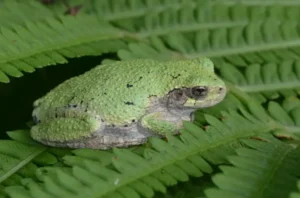
| Average Adult Size (Length) | 1 – 2 inches |
| Average Lifespan (Years) | 7 – 9 |
Cope’s gray treefrogs very closely resemble the gray treefrog (H. versicolor). In fact, these two frog species are visually identical, the main way to tell them apart (besides genetic testing) is by their call.
The call of the gray tree frog is a melodic birdlike trill while the call of Cope’s gray tree frog is a rapid high-pitched buzzing trill.
Cope’s gray treefrogs grow between 1 and 2 inches in length. They vary in color from mottled gray to light green with irregular dark blotches on the back, but their color can change depending on the environment and activity
There is usually a light spot beneath the eye and the inner thigh is bright yellow or orange when exposed.
In Minnesota, Cope’s gray treefrogs can be found in the southeastern, central, and northwestern parts of the state, where they share their range with gray tree frogs.
They are often found in a variety of wooded habitats but are most common in mature deciduous forests.
3. Spring Peeper (Pseudacris Crucifer)


| Average Adult Size (Length) | 0.75 – 1.5 inches |
| Average Lifespan (Years) | 3 – 4 |
Spring peepers are small frogs, only growing between 0.75 – 1.5 inches in length. They get their name from the short, loud, high-pitched chirping call they make. In some places, the sound of spring peepers is seen as one of the first signs of spring.
These frogs can be easily identified by their tan, yellow, gray, olive, or light brown coloration with a dark X-shaped marking on their back.
The X-shaped mark may be very faint in light-colored frogs or dark on darker ones. A dark line runs across the top of the head and between the eyes, and there are dark bars on the legs. The belly is a plain cream color.
Like most other tree frogs, spring peepers have noticeable adhesive pads (which look a little like disks) on their fingers and toes.
These frogs have vocal sacs that expand and deflate like balloons to create a short and distinct peeping sound. Only males can make this noise, and they use it to attract mates.
The male spring peepers often perch on grass, branches, and other vegetation near water and call out for mates – often repeating their “peep” about 15-25 times a minute.
Usually, many spring peepers call at the same time, and their calls sound like hundreds of small sleigh bells!
In Minnesota, spring peepers are common throughout the eastern, central, and northwestern parts of the state – where they are often found in moist, wooded areas, fields, and grassy lowlands near ponds and wetlands
Spring Peeper Range. Map By: United States Geological Survey.
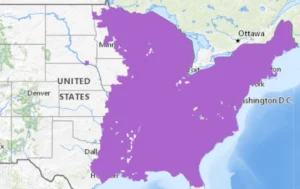
4. Boreal Chorus Frog (Pseudacris Maculata)
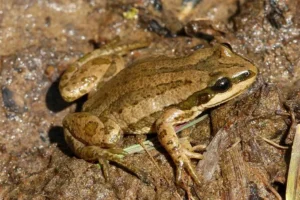
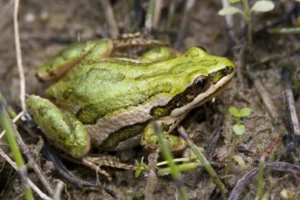
| Average Adult Size (Length) | 0.75 – 1.5 inches |
| Average Lifespan (Years) | 3 – 5 |
Boreal Chorus Frogs grow between 0.75 and 1.5 inches, with an average body length of only 1 inch which makes them one of Minnesota’s smallest frogs. They get their name from their call which resembles the sound produced when running your fingernail over a fine tooth comb.
These frogs have a very varied coloration but generally range from brown, tan, gray, orange, green, or olive with a pattern of three stripes running down the back, which are often broken into blotches or spots. Commonly two of these strips run through the eye, extending to the tip of the nose.
Boreal Chorus Frogs have rough, granular skin, and their feet generally lack webbing. Like other tree frogs, they have slightly enlarged toe pads to help in climbing grasses and other vegetation.
Boreal Chorus Frogs look very similar to the Spring Peepers and are often confused for the latter. A simple way you can tell them apart is to look at the back: Boreal chorus frogs have lines running on the back, while spring peepers have an X-like shape.
These frogs live throughout Minnesota – and are often found in open habitats such as wetlands and moist fields near trees, but they sometimes wander into urban areas.
Boreal Chorus Frog Range. Map By: United States Geological Survey.
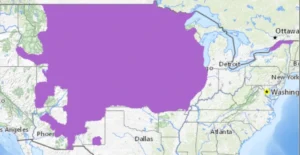
5. Blanchard’s Cricket Frog (Acris Blanchardi)
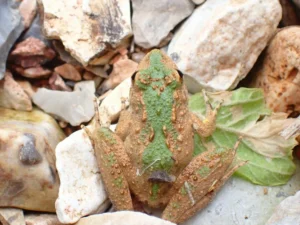
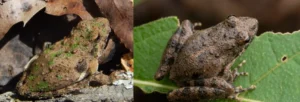
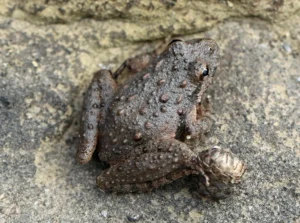
| Average Adult Size (Length) | 0.6 to 1.5 inches |
| Average Lifespan (Years) | 1 year |
Like the boreal chorus frog, Blanchard’s cricket frogs are small, only growing 0.6 to 1.5 inches in length. They have warty skin that is usually brown, gray, tan, or olive green, with darker bands of color on the legs.
Down the back, there is an irregular stripe, which may be green, yellow, orange, or red. The belly is white.
They get their name from the cricket-like call males of this species use to attract mates and keep away other males.
Despite being classed as tree frogs, Blanchard’s cricket frogs generally do not climb trees, rather they live along the edges of streams, ponds, and ditches.
Since they live very close to water, their feet are strongly webbed, and the adhesive pads that are prominent on the fingers and toes of most tree frogs are poorly developed.
Blanchard’s Cricket Frogs are a similar size to the Chorus frogs, so it can be easy to confuse them for the latter. The main way you can tell them apart is; Chorus frogs have a pattern on their back, while cricket frogs generally lack any real pattern on the back.
In Minnesota, Blanchard’s Cricket Frogs have only been reported in Hennepin and Winona counties and a single unverified sighting in Rock County. They are Minnesota’s only endangered amphibians.
Blanchard’s Cricket Frog Range. Map By: United States Geological Survey.
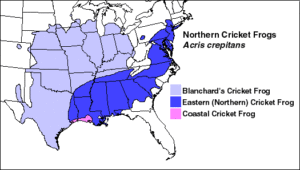
Frequently Asked Questions (FAQS)
Are tree frogs in Minnesota poisonous? Cope’s gray treefrogs are the only poisonous treefrogs in Minnesota. They produce a poisonous skin secretion that makes them taste bad to many would-be predators. This secretion is very irritating when it comes in contact with your eyes and mucous membranes. It is also irritating to dogs or cats that ingest it via the mouth or eyes.
What are green tree frogs in Minnesota? There are three green tree frogs in the state of Minnesota: Gray treefrogs, Boreal chorus frogs, and Blanchard’s cricket frog. If you ever a green-colored tree frog in Minnesota, it’s probably one of these.
Conclusion
Minnesota has at 5 treefrog species, with some species being more common than others.
These treefrogs are all over Minnesota, and you’re sure to catch sight of one if you take the time to look, especially in the spring when they are most active.
Photo credit:Judy Gallagher, CC BY 2.0, via Wikimedia Commons. ozarkpoppy, via inaturalist.5 Interesting Types of Tree Frogs in Minnesota (+ Pictures)

